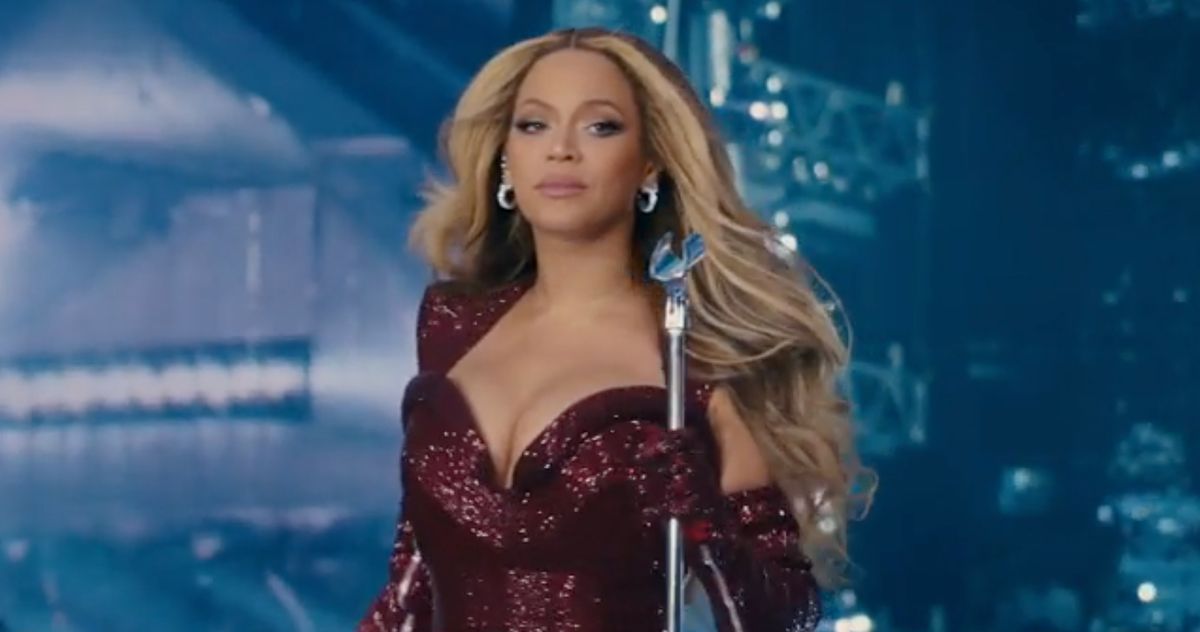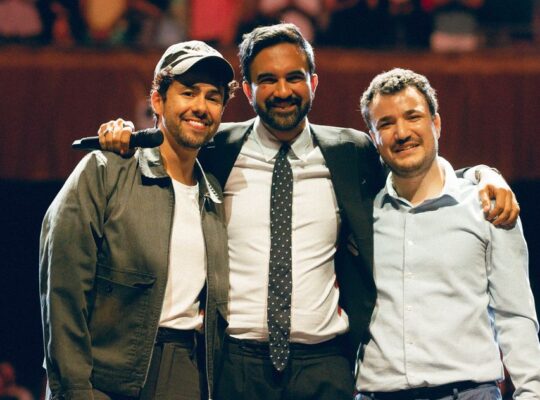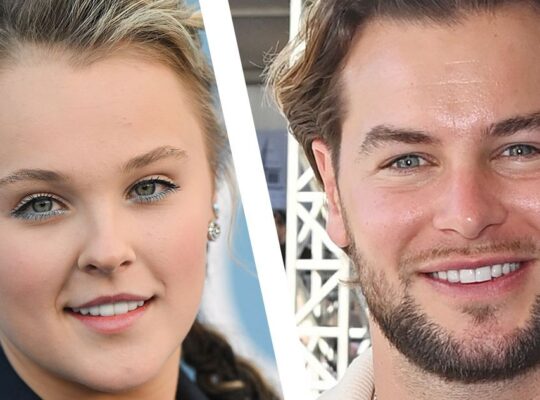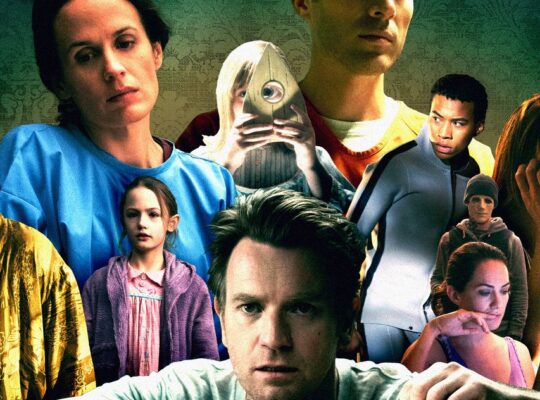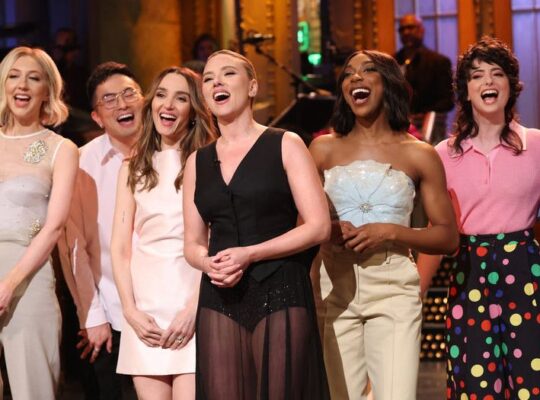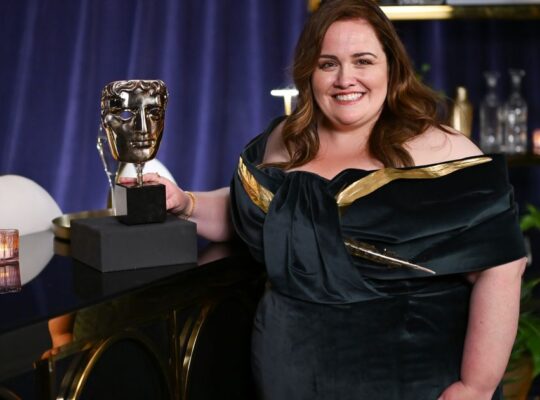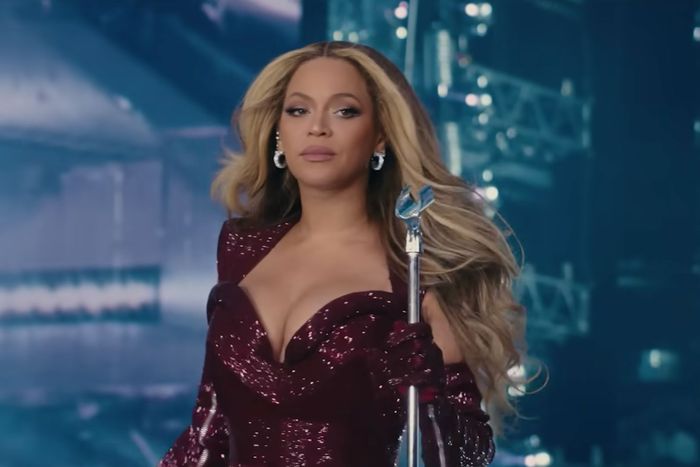
Photo: Beyoncé via YouTube
You can’t turn the stage into a pussy portal if you’re not going to serve cunt. By the time we see a straight-on shot of Beyoncé’s legs spread open in a VCR interlude — heeled feet stretched to each side of the gargantuan screen, bisected by a chrome orifice — she’s already mesmerized the audience to the point of tears. I watched the very first show through a microwave-quality, 360p Instagram livestream after scamming my way into free Wi-Fi during a cross-country flight. Even the shaky handheld camera work and the screechy vocal stylings of that generous copyright infringer couldn’t obscure the glittery brilliance of the house mother’s inaugural ball. Stockholm hosted the debut extravaganza last May, 285 days after the album ushered in her Black dance-music rebirth. Between innovative production design, ballroom-inspired choreography, and rotating couture quick-changes, Beyoncé came to slay, bitch.
Renaissance: A Film by Beyoncé tries to break the trance she put us in this summer, if only slightly. Written, directed and produced by the star, the 168-minute concert documentary pulls us into a state of near bliss as we watch her spill confidence and Black queer history and vocal prowess all over the stage, only to cut away from the performance to highlight the process. So what if her triumphant renditions of “Dangerously in Love” and “Flaws and All” had you catching your breath? It’s time to hear about the craftspeople and queer legends and dancers and Uncle Johnny, who made all this possible. “I wanted to embrace the bones and the veins of the machinery,” Beyoncé says in voiceover. “It’s more than a concert. It’s a culture. It’s a release. It’s a fantasy come true.” Here’s everything we learned.
While Renaissance certainly feels like a joyous, post-COVID album, the tour has been cooking since before the pandemic, Beyoncé reveals. “It took four years to create this show,” she says. Meaning, the tour was likely gestating just after she did Beychella. “I think the true beauty is in the process.” Flipping through a fat binder filled with laminated stage designs, we see just how many iterations the show went through during pre-production. “I wanted to showcase the crew, so I put them in reflective crew suits because I think it’s really beautiful to see the choreography of what they do,” she adds. “Every piece of the puzzle was so meticulously built, if one element is off, it affects the whole show.”
To get each show up and running, it took three stages and 160 vehicles working in concert across Europe and North America. “As one is getting set up, the other two stages are traveling to the next city and getting built.”
Though Beyoncé is an experienced artist, she still faced difficulties during production. “Communicating as a Black woman,” she says, “everything is a fight.” There’s meetings with lighting designers and camerapeople over little details. At one point, even Blue Ivy says she’s being too meticulous for worrying about the fingers on an inflatable. “Swarm on these hands,” Beyoncé tells a crowd while performing “America Has a Problem.” She didn’t come to play.
Ballroom MC Kevin JZ Prodigy narrates the tour with his swaggering vocals, and the film gives him a proper section to celebrate his artistry. A cameraman catches a sweet moment between him and Beyoncé where they express their gratitude for working together and share a hug. “You’re so small,” Prodigy gushes. We also watch him take his perch on the DJ booth for the show, guiding the audience through each set change with his signature cheeky remarks prepared in consort with Bey.
In contrast to her previous shows, Beyoncé exhibited less breakneck choreography for this round. “My voice is my instrument,” she explains, “power comes from restraint.” It didn’t help that she underwent a knee surgery just a month before rehearsals began. Instead, she trains the focus on the dancers. Longtime dance captain Amari Marshall and the team flank Beyoncé in compelling formations or delicate tableaus. Choreographers took inspiration from the ballroom scene to incorporate dance styles like vogue and whacking, a nod to the cultures that informed Renaissance’s musical style. Dancers like Honey Balenciaga, Carlos Irizarry, Darius Hickman, and Jonté Moaning have roots in the scene and take the spotlight throughout the film.
Due to the rigors of touring and the smoke effects on stage, Beyoncé suffered near-constant sinus infections and was once treated for bronchitis. She believes a vocal injury she overcame at 12 years old helped prepare her for adversity, citing the moment she was on vocal rest and couldn’t even scream on a roller coaster. We see a montage of the powerhouse getting IVs and checkups. “I don’t think I’ve had a day off in 44 days,” she says.
Ateliers across the globe rejoiced at the Renaissance tidings more than anyone else. Throughout the run, Beyoncé wore 148 costumes designed by couture fashion houses and indie upstarts, leaving audiences and high fashion Twitter more gagged by the day. Beyoncé knew the cuts between different outfits would have a kaleidoscopic, Everything Everywhere All at Once effect (see the 18-second spot she released on YouTube last year, the only visual we have gotten for the album). Why else would camera movements and choreography be so tightly choreographed if not to seamlessly edit five different outfits for just one song? Audiences are blessed with that gloriously draped lime green Gaurav Gupta dress, the silver Marine Serre motherboard jumpsuit with the red gown overlay, a David Koma iridescent leotard with the matching sarong. That’s not even mentioning her revolving door of shimmering Loewe catsuits, the Philosophy di Lorenzo Serafini cone bra, or the colorful Emilio Pucci checkered number.
She has to have a sandwich and a ginger shot ahead of any performance. The one time she didn’t have a sandwich, the audio cut out. The same thing happened when she didn’t take her shot. Her lunchmeat of choice might be turkey, if the sandwich she ate on her private jet is anything to go by.
Beyoncé’s family friend, the late Uncle Johnny Rittenhouse, gets a shout-out in the track “Heated” for designing Destiny’s Child early stage costumes, together with her mother, Tina Knowles. In the film, Beyoncé wears the dress that he made her. House “is the music that he played for them as kids,” Knowles remembers.
Famous faces make cameo appearances at various points in the film. Beyoncé fans Lizzo, Teyana Taylor, and Lil Nas X are filmed with the same reverence as their BeyHive counterparts. We watch as they sing along to the queen Club Renaissance, the floor section. When Beyoncé looks around during the mute challenge, we see a hilarious video selfie of Cardi B in the crowd, who looks at the camera, knowing she understood the assignment.
Beyoncé brings the old gang back together in a brief behind-the-scenes sequence. Original members LeToya Luckett and LaTavia Roberson, who were allegedly pushed out of the group, join Kelly Rowland and Michelle Williams for a reunion at the Houston tour stop. “It was like a new birth for us, and a lot of healing,” Beyoncé says over the seconds-long footage. We don’t hear dialogue from the meeting.
Beyoncé’s manager wouldn’t let the tour suffer from a glaring omission. During the ecstatic run from “Cuff It” and “Break My Soul” to “Formation” and “Diva,” we cut to a contentious meeting. Apparently, there was some talk that “Diva,” a performance that gave us the delicious “She ain’t no diva” meme, would not make it on the final set list. “You can’t take away that song!” Blue Ivy pushed back. Her mom scolded her for cutting people off. Whatever, Blue won in the end — and we got our meme.
Elsewhere, we learn the 11-year-old’s performance on stage was supposed to be a one-off. “She told me she was ready to perform, and I told her no,” Beyoncé says in the film. Her mom relented when Blue showed dedication and work ethic, but that one show became most of the tour. After reading hater comments, Blue wanted to prove herself. “The more I did it, the better I became,” Blue realizes. For Beyoncé, she saw her daughter’s determination as a telling moment, “That’s my bloodline,” she says, “ready for war, let’s go.”
“That’s a Knowles,” Blue’s grandpa, Mathew Knowles, proudly remarks.
Her final gift to the BeyHive arrives just when the movie is over. Co-produced by Beyoncé and The-Dream, it sounds like a Houston rap joint, only for it to dive back into Renaissance-era electronic bumps and a Jersey Club-reminiscent sound.
Because this one makes it in the movie.
Source link


